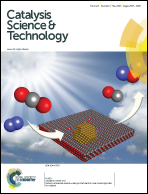Effect of SiO2/Al2O3 ratio on the activities of CoRu/ZSM-5 Fischer–Tropsch synthesis catalysts
Abstract
ZSM-5 materials with different SiO2/Al2O3 ratios (25, 50 and 80) were used as supports to prepare ZSM-5-supported CoRu Fischer–Tropsch synthesis (FTS) catalysts. The presence of polyethylene glycol molecules in the solution could deposit most of the Co3O4 particles on the exterior surface of the ZSM-5 support, leading to a high extent of reduction in the prepared CoRu/ZSM-5 catalysts. The use of ZSM-5 with a high alumina content (SiO2/Al2O3 = 25, 50) facilitated the production of more Brønsted acid sites on the supported CoRu catalysts, however, dealumination was favored during the preparation of these catalysts. The defects formed in the framework preferred to interact with the metallic Co0 particles in the reduced CoRu/ZSM-5 catalysts. The resultant electron-deficient Co0 sites thereby strongly adsorbed H species, resulting in the lower turnover frequency (TOF) in the FTS reaction. Decreasing the SiO2/Al2O3 ratio to 80 reduced the number of Brønsted acid sites on the catalyst, however, it avoided the unexpected dealumination. As a result, although the reduced CoRu/ZSM-5 catalyst with a SiO2/Al2O3 ratio of 80 had lower selectivity of gasoline-range hydrocarbons, it showed an about 2-fold higher TOF value than the reduced CoRu/ZSM-5 catalysts (SiO2/Al2O3 = 25, 50) in the FTS reaction.


 Please wait while we load your content...
Please wait while we load your content...